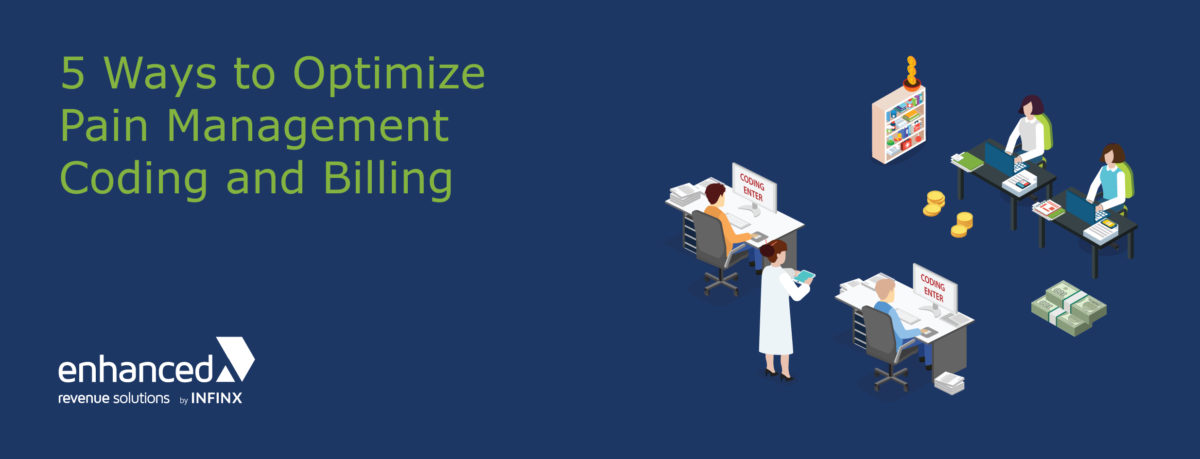With millions of people in the United States suffering from severe and ongoing pain – chronic pain management has become a significant public health problem costing society billions of dollars in lost time and productivity while negatively impacting peoples’ lives. A recent report from the Centers for Disease Control (CDC) estimates that over 50 million people suffer from chronic pain, which equates to 20.4% or 1 in 5 adults.
As the population ages and the incidents of long-term pain from arthritis or other age-related conditions rise, these numbers will increase, and the pain medicine specialty will continue to expand. Already the subject of significant scrutiny from insurance payers, pain management services are caught in the crossfire of expanding prior authorization requirements, downward adjustments to fee schedules, and shifting financial responsibility to the patient.
Identifying the Top 5 Issues in Pain Management Coding
More important than ever, a state-of-the-art revenue cycle management process that includes solid coding and billing practices allows your practice to be paid for work in a timely, efficient manner. Let’s look at the top five errors pain medicine practices make when coding visits to ensure maximized reimbursement now and in the future:
- Be Sure to Document Appropriately for the Visit — Complete and accurate documentation is more important than ever in pain medicine with denials issued due to missing information on a variety of issues, i.e., laterality or which nerves were treated.Pain medicine providers must include thorough, accurate treatment information in the original operative note or an addendum. Once sent to the business department, coders must be experts at clarifying information found in the notes and coding appropriately based on the latest coding guidelines.
- Ensure Your Practice is Up to Date on Payer Policies and Guidelines — Understanding that there are thousands of insurance companies, providers, and coders need to stay current on insurance payer policy changes to ensure maximum reimbursement. Sometimes this requires detective work to glean information from updates and documentation coming from the vast array of payers.With coding and billing, the major changes are usually announced in the final quarter of the previous year with effective dates of January 1st. However, information can change throughout the year. A good example has been the telehealth changes that impacted patient E/M codes and ICD-10-CM codes during the COVID-19 pandemic.
- Understand When to Bill Fluoroscopy Separately — Many pain management practices bill for fluoroscopy separately from the procedure. Be sure to understand if this is a bundled charge for the procedure used, i.e., SI joint (27096), medial branch blocks, and facet injections, or is it recognized separately, i.e., fluoro guidance codes for peripheral joints.
- Critical to Reimbursement is the Use of Modifiers — Modifiers exist to clarify the service or procedure done and can trigger denials or negatively impact revenue when missed or used incorrectly. Consider the following:
- -LT –anatomically left-RT –anatomically right
- -50 – bilateral
- -59 – notes that a service or procedure is independent and separate from other services that were performed on that same day
- -52 – incomplete procedure – stopping part of the procedure due to reasons other than patient well-being
- -53 – incomplete procedure – the physician chooses to end a procedure for the patient’s well-being.
- Be Mindful Not to Exceed Limits on Approved Numbers of Procedures — Pain medicine requires careful oversight of numbers of procedures performed compared to approved visits allowed. It is quite common to exceed the limit prescribed and then have the visit(s) disallowed.
Critical to the success of any pain management coding and billing program, is avoiding anything that might trigger a post-service prepayment coding review from insurance payers. Insurance-mandated coding reviews can add up to 180 days (or six months) to receiving payment, which will devastate the bottom line — and that’s if you get paid.
An alternative may be to consider engaging a third-party partner who has the expertise to code and bill efficiently but can also scale without issue and maintain the training and updating required to stay at top-form.
Contact us to learn more about optimizing your pain management coding and billing workflow.










Comments are closed